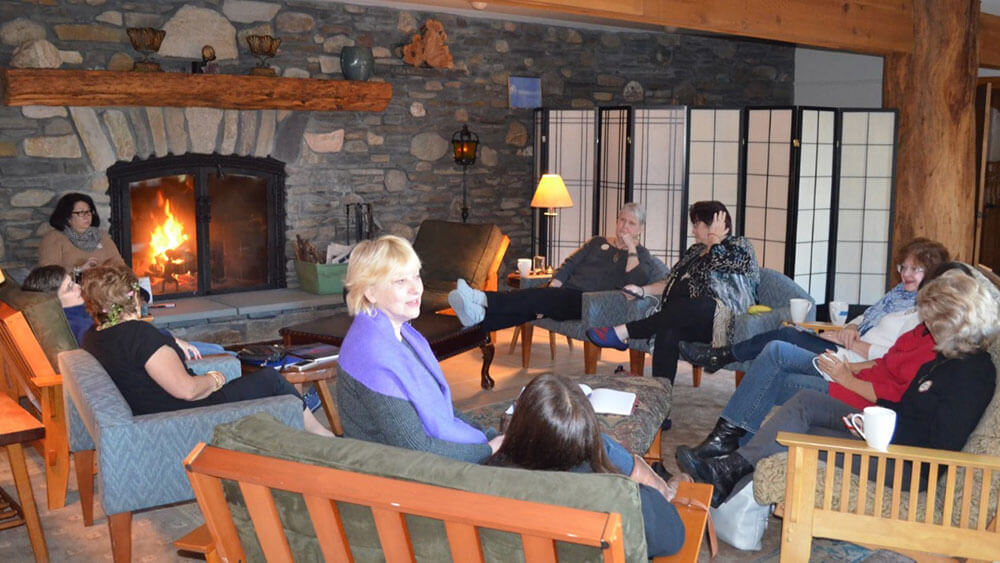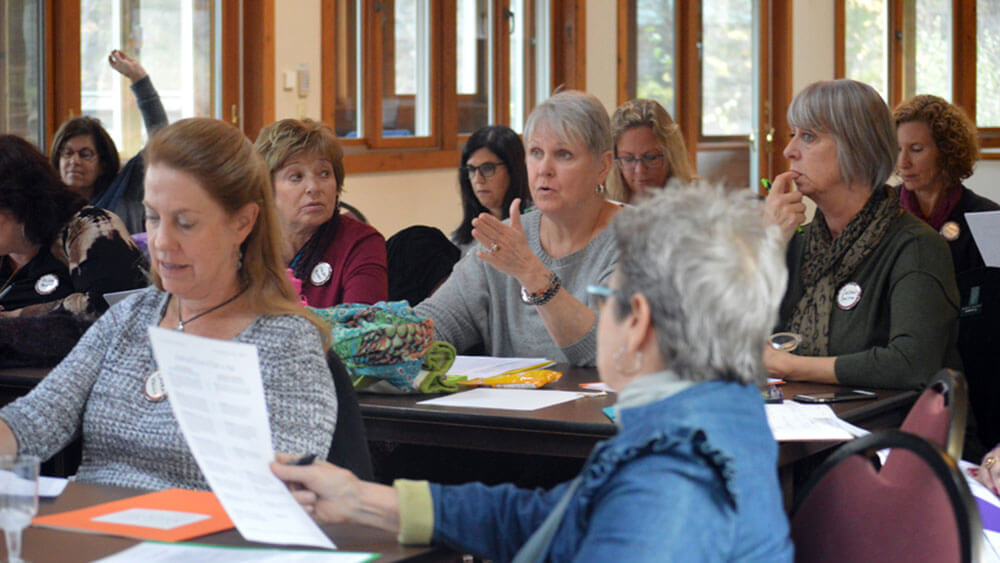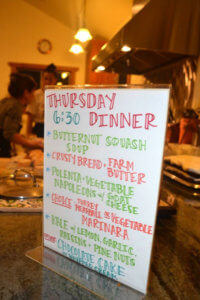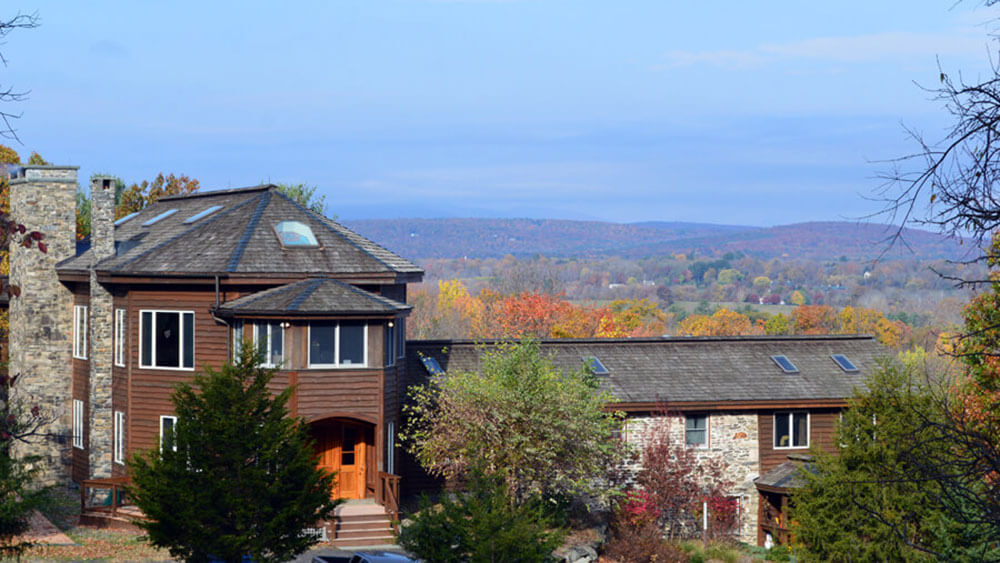
Participants at the 2016 Women at Woodstock retreat.
When asked how she launched Women at Woodstock — an annual weekend retreat for women over 50 held for the past five years in upstate New York — Ann Voorhees Baker is quick to point out she doesn’t have a background as an event organizer. She has had an eclectic career, however: She started out as an attorney, then published a parenting magazine that evolved into a marketing and communications firm, which she sold to concentrate on a solo practice as a writer, web designer, and social-media-marketing consultant.
The retreat actually began as a personal gathering. Turning 50 and going through a divorce, Baker decided to rent a cabin in the woods and invited about a dozen friends for the weekend — to go on hikes, cook meals together, drink some wine, “and maybe watch chick flicks,” she said. On the last night of their get-together, she passed around basket of random questions and asked each of her friends to pull one out and answer it, or choose one more to their liking — questions like, What’s something that you are most proud of that you’ve done in your life? What’s your biggest regret? Describe a turning point or your most embarrassing situation in your life, and so on, she said.
“Women shared things that were amazing,” Baker recalled. “There was something powerful about having a still moment after having lived together for a couple of days, to have the floor, to reflect, and then know that everyone has agreed that they will listen to what you have to say.” One woman talked about how she had given up her dream of being an artist to raise her children and suddenly realized how much she missed it. Another woman said that she was at her wits’ end looking for a job — and someone told her about an open position that she thought would be a good fit for her. “She actually got hired for that role and the woman who had talked about her art career started painting again,” she said. The “shift” that had occurred for the women that weekend “hung in my mind,” Baker said.
After a few years, she decided to recreate that experience by inviting her clients from all over the country, almost all of whom are women over 50, to get together “for a weekend like I had in the woods with my friends before.”

Discussions during a workshop.
Not a Conference

A local and health-conscious caterer prepares the group’s meals, focusing on vegetarian dishes and locally sourced food.
Baker had attended business conferences and networking events and found them overwhelming, so that was not a model she aspired to follow. “They made me feel at times very small,” she said. “There are the big experts up on the stage and there are 500 of us in this room and I’ve got my binder and my notes and it’s an onslaught and then I go home and I put it in a pile and I eventually throw it away. I said I want to have a place where we can just go, be totally casual. We’ll network, but in a whole different setting at a whole different pace. We’ll have workshops, we’ll have speakers — there’s a purpose to it.” Speakers at the inaugural Women at Woodstock in 2012 came from different fields and included Suzanne Braun Levine, the original editor of Ms. magazine.
Baker has kept the retreat to under 40 women. “It’s not an event that I intend to grow into the thousands,” she said. “It’s a little perplexing that way because this is not a business model for generating a living all on its own. It’s a passion thing. I originally thought I would grow it up to a maximum of 100 women, but after I’d done this for a couple of years I thought even that is probably too much for what we do and what we accomplish. It probably would break the spell.”
The setting — the Catskill Mountains in early fall — also helps cast that spell. Baker first held the retreat at the Emerson Resort & Spa in Woodstock, New York, which she said was “absolutely gorgeous, but it had a hotel quality as far as how you felt while you were there.” So last year, she moved the event to nearby Lifebridge Sanctuary, a “beautifully renovated and expanded farmhouse,” she said, that’s “full of light, has wood floors and stone walls, and is powered by solar power. It’s set off, on its own in the hills and we have the whole place to ourselves. The maximum capacity there is 36 women, so it’s kind of perfect.”
Baker markets Women at Woodstock — and has added a writers’ retreat this year the following weekend — through emails and Facebook and Google ads. She has several attendees who come back every year. “The result is the women who come are so well aligned and compatible that it is a fantastic experience,” she said.
For organizers of large conferences who want to add a retreat-like element to their programs, Baker offers a few recommendations:
If at all possible, give them an overnight experience. “You form friendships and you get a little bit into that Girl Scout camp mode,” Baker said. “It’s hard to make that connection over lunch between workshops or at the dinner after workshops. There’s something about sharing the living space.”
Make speakers into participants. “Our speakers are there for the weekend,” Baker said. “They’re not just on stage and boom, they’re gone, and you run up to them hoping you can ask them a question before they exit. They’re hanging out. They’re having lunch. They’re going to other workshops. I tell my speakers, I want you to be part of the group so that those conversations can be natural and flow throughout the weekend. We all feel like we’re in this together, we’re not peons watching the experts tell us what we should know. That changes the flavor quite a bit.”
Create interest groups. If she were planning a big conference, Baker said she would let participants self-select an interest group, “and create little houses, sort of the Harry Potter schools idea where you come to the conference but you’re in the ‘Writers House’ or the whatever house,” she said. She said that if you could have each interest group stay on its own hotel floor, that would help “make them feel like they are part of a smaller group.”
Carve out smaller, shared spaces. Give attendees “some kind of setting where they — as their own smaller group — can get together in a lounge or a smaller restaurant on site,” Baker said, “where they can calm down, and really have a genuine conversation as a group rather than, ‘Oh I’m talking to you one-on-one but I need to run over there and try to talk to her one-on-one because I know that she knows something else.’ That group conversation is just a powerful thing to have.”

Lifebridge Sanctuary served as the location for the most recent Women at Woodstock retreat.
